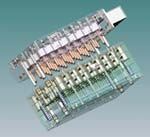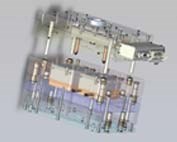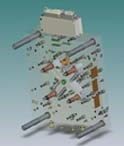Integrating Hot Runner Mold Construction
Realize time and cost saving benefits from the use of integrated systems when compared to traditional hot runner manufacturing methods
Hot runner molds are inherently complex. They have to bring together time, temperature, flow and the pressure of plastics operating on rapid cycles. The mold needed to accomplish this can be complicated, but with straightforward planning, the process of building a hot runner mold can be a relatively simple one.
Traditionally, the process of hot runner mold building involves having the mold base and the hot half manufactured by different suppliers and then fitted together onsite, but there is another approach: an integrated mold building process.
An integrated process brings together—under one roof—all of the materials and components to construct a complete hot runner system. An integrated mold building process can offer a host of efficiencies and avoid problems associated by having mold bases and hot halves manufactured by different suppliers.
The original design of a plastics part can come from either the molder or a part designer affiliated with the molder. Changes to the part and/or the mold design can be made at any time, right up to the start of production. However, there has to be some discipline in the process in order to move from design to production. It has often been said that a finished part will never see the light of day unless someone locks up the design engineers and starts production.
Every effort should be made to minimize last minute design changes. Changes can affect production of the hot half, the mold base or both. In any event, construction of the mold base and the hot half by one builder can accommodate inevitable changes more efficiently.
Theoretically, a hot half and mold base produced from the same set of drawings should fit together perfectly. For a host of reasons, when multiple suppliers are involved, many issues can arise. When both elements are built by the same supplier, putting responsibility in one place guarantees that the mold base and the hot half will fit together as designed. It also is important that cavities be interchangeable, so that a cavity that develops problems, for whatever reason can be readily replaced and production can continue. Figure 1 illustrates a basic four-drop, hot-half design.
Mold Base Components
P20 is perhaps the most widespread choice of steel for the mold base and hot runner plates. In addition, modified P20 pre-hardened chromium/molybdenum alloyed steel, with good polishing and texturing properties, supplied at 285-340 Brinell hardness is often used. When steel, other than P20 is needed, the choice would take into account machinability, durability, thermal conductivity and availability.
An integrated systems builder takes responsibility for acquiring and installing all components, such as hot runner nozzles (see Nozzle Technology Sidebar) and electronic hot runner controls. Assembly and testing are the final steps, after which the mold is ready for installation in the processor’s injection molding machine. Components such as side locks, pins, sleeves and water fittings can pose complications when mold manufacturing is multi-sourced. These complications are easily addressed when an integrated-system supplier builds the entire system. Figure 2 shows the base half and the hot half of a two-drop mold that illustrates the integrated system.
Some Pitfalls of Multiple Sourcing
The following example illustrates the pitfalls of ordering a mold from multiple suppliers and points to the benefits of using one source for both the hot half and mold base.
Suppose that ABC Company wants to order an eight-drop hot runner system and a mold base for a rush job. Targeted delivery for the finished tool is eight weeks.
ABC wants to get quotes from three competing sources. ABC sends engineering part drawings in 2-D format with specifications to the three potential suppliers. The part drawings are then sent to ABC’s mold designer, requesting preliminary design completion in one week.
A quote from one hot runner supplier comes in the next day. Nothing is received that day from the other competing hot runner suppliers. Finally, on day three the other hot runner quotes arrive.
The following week ABC’s mold designer completes the preliminary mold design, which is sent out for quotations. Mold base suppliers send in quotes over the next three days. Mold drawings are then sent to the hot runner suppliers and quotes are finalized, each committing to a delivery date.
ABC selects a hot runner supplier out of the three competitors and issues the purchase order, requiring a six-week delivery time. ABC also selects a mold base supplier and issues the purchase order, requiring the A and B plates arrive with finished pockets and a one-week delivery.
On week three the hot runner supplier completes the hot half design and sends it in 2-D format for approval. ABC then sends the design to their mold designer, who forwards it back with some changes to leader pin and screw locations to avoid interference with water lines. ABC also asks to see the hot half design in 3-D format.
During week four the hot runner supplier resends the drawings for approval, and pushes out the delivery date, which upsets ABC Company, since 3-D drawings had to be contracted out.
In week five the mold base supplier telephones to report that he has a water line in the wrong location and asks ABC to accept the error or expect a delivery delay. ABC forgets to inform the hot runner supplier about the water line error. During weeks six and seven work continues at the mold base and hot runner suppliers.
During week eight the mold base arrives, but the hot half is late.
During week nine the hot half arrives, but does not fit the mold base. ABC needs to correct the leader pin location and then discovers the water line location interferes with the assembly of the hot half.
Multiple suppliers, ongoing design changes, errors and miscommunication often result in significant manufacturing rework, unbudgeted and increased tool cost.
The Integrated Approach
Finding a hot runner supplier that integrates both the hot half and the mold base into a single mold package is an alternative approach to multiple sourcing. This approach assures that both are designed and machined to customer specifications.
In an integrated system approach, the use of one purchase order can cover both system halves. The base half also can be shipped ahead of the hot half if the customer desires. When the molder orders a completely integrated system from one supplier, significant savings can be realized. By keeping design, manufacturing, testing and assembly responsibilities with one supplier, errors, rework and costs are minimized while communication, redesigns and delivery expectations can be executed effectively. Cost efficiencies at the supplier level often mean price savings for the customer.
In an integrated system approach everything can be prepared in 3-D; optimized designs are created; and existing off-the-shelf drawings are not used. The supplier can start with either the part or the mold and then collaborate with designers already involved with the project. Figure 3 shows a 32-drop integrated system mold that combines the base half and the hot half, both shown here.
An integrated system supplier also can bring the A side of a mold into their facility and retrofit a hot runner manifold.
Summary
Integrated hot runner systems have been installed and are in use within several industry segments including automotive, medical, aerospace and consumer products. With the inherent advantages that an integrated system can offer, molders can benefit from time and cost savings when compared to traditional hot runner manufacturing methods.
Related Content
6 Ways to Optimize High-Feed Milling
High-feed milling can significantly outweigh potential reliability challenges. Consider these six strategies in order to make high-feed milling successful for your business.
Read MoreThe Ins and Outs of Hot Runner Temperature Control
A training checklist that explains the why and how of proper hot runner temperature control and system management.
Read MoreSolving Mold Alignment Problems with the Right Alignment Lock
Correct alignment lock selection can reduce maintenance costs and molding downtime, as well as increase part quality over the mold’s entire life.
Read MoreFundamentals of Designing the Optimal Cooling System
The right mold components can help improve mold cooling and thereby produce higher-quality parts.
Read MoreRead Next
How to Evaluate Hot Runner Nozzless
The way to choose the right hot runner nozzle is to evaluate the entire molding system first.
Read MoreHow to Use Continuing Education to Remain Competitive in Moldmaking
Continued training helps moldmakers make tooling decisions and properly use the latest cutting tool to efficiently machine high-quality molds.
Read MoreReasons to Use Fiber Lasers for Mold Cleaning
Fiber lasers offer a simplicity, speed, control and portability, minimizing mold cleaning risks.
Read More














.jpg;maxWidth=300;quality=90)









